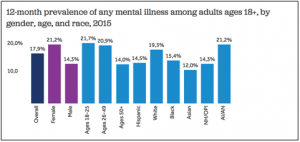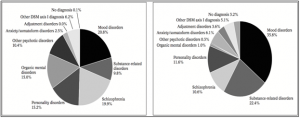Key emotions that affect youth psychology:
- Anger
- Sadness
- Joy
- Fear
What do we fear about Mental health issues? What do we fear about addressing them?
- Fear of the unknown
- Fear of being judged
- Fear of not having access to resources if they are needed
- Fear of being excluded by people whom we love
- Lack of knowledge
- Fear of being a non-normative being (as expected and assumed by society)
- Reservations from the family end
- Inconfidence and inconvenience.
The lack of knowledge and the fear society has infused in most of us has eventually inhibited us from addressing the lack of knowledge and the fear society has infused in most of us has eventually inhibited us from addressing our problems in the open due to which, mental problems often remain unexplored. One must understand that mental health is equally important as physical health and if not detected, treated; can cause serious damage in all aspects of human life.
Trending disorders (between age group 10-26 between middle-higher socio-economic background)
- Depression is one most devouring troubles that has been affecting the youth since a very long time. It causes all sorts of extra-problems in our regular life. Starting from job life to social to familial, everything can go for a toss under depression. With the enough performance-pressure we are already facing, depression alongside can be a deadly trauma for us.
- Performance pressure is another dangerous thing in our life causing all productivity to be sapped and, in the end, we are nothing but mechanical. Creativity is lost, and the life energy required for working or giving efforts is lost. The pressure to perform the best or above average is very high. Starting from education to job everything runs the rat-race and in-between this, an individual loses all his/energy to focus, create and be productive.
- The maximum of the Suicide is because of this defenceless against the huge pressure of everyday life. Food, clothing, lifestyle maintenance everything is only escalating with growing day. The cost, money-factor has made humans nothing more than pressure cooker which when goes off, creates ripple of disaster.
- Worldwide 10-20% of children and adolescents experience mental disorders.
- Half of all mental illnesses begin by the age of 14 and three-quarters by mid-20s.
- Neuropsychiatric conditions are the leading cause of disability in young people in all regions.
- Around 65% youth between the age group of 22-25 show early signs of depression
- Lack of sleep is a prominent cause of poor mental wellness, whereas the overall mental wellness levels among women is higher (66%) when compared to males (55%), the survey revealed.
Common mental illness prevalent with symptoms:
| Anxiety disorder |
|
| Attention deficit/hypertension-disorder |
|
| Eating disorder |
|
| Intention self-harm |
|
| Mood disorder (depression & bi-polar disorder) |
|
| Psychosis and schizophrenia |
|
| Substance misuse |
|
| Suicide |
|
The young people in the age group of 10-24 year in India constitutes one of the precious resources of India characterized by growth and development and is a phase of vulnerability often influenced by several intrinsic and extrinsic factors that affect their health and safety. Nearly 10-30 per cent of young people suffer from health impacting behaviours and conditions that need urgent attention of policy makers and public health professionals.
Nutritional disorders (both malnutrition and over-nutrition), tobacco use, harmful alcohol use, other substance use, high risk sexual behaviours, stress, common mental disorders, and injuries (road traffic injuries, suicides, violence of different types) specifically affect this population and have long lasting impact. Multiple behaviours and conditions often coexist in the same individual adding a cumulative risk for their poor health. Many of these being precursors and determinants of non-communicable diseases (NCDs) including mental and neurological disorders and injuries place a heavy burden on Indian society in terms of mortality, morbidity, disability and socio-economic losses. Many health policies and programmes have focused on prioritized individual health problems and integrated (both vertical and horizontal) coordinated approaches are found lacking.
WHO an estimated 2.6 million young people aged 10 to 24 yrs. die each year and a much greater number of young people suffer from illnesses ‘behaviours’ which hinder their ability to grow and develop to their full potential. Nearly two-thirds of premature deaths and one-third of the total disease burden in adults are associated with conditions or behaviours initiated in their youth (e.g. tobacco use, physical inactivity, high risk sexual behaviours,
[1] http://www.who.int/maternal_child_adolescent/topics/adolescence/mental_health/en/
injury and violence and others). The behavioural patterns established during this developmental phase determine their current health status and the risk for developing some chronic diseases in later years. A significant reduction in the mortality and morbidity of communicable, maternal and neonatal disorders since 1990 due to concerted and integrated efforts led to a shift in focus towards the health, safety and survival of the young people. It is crucial to understand health problems of this population, processes and mechanisms that affect their health, identify interventions and strategic approaches that protect their health and develop and implement policies and programmes.
The present review focuses on the health behaviours and problems affecting young people in the age group of 10-30 yrs. in India.
At least 20 per cent of young people are likely to experience some form of mental illness – such as depression, mood disturbances, substance abuse, suicidal behaviours, eating disorders and others. A meta-analysis of five psychiatric epidemiological studies yielded an estimated prevalence of mental morbidity including 16 mental and behavioural disorders (classified into eight groups of organic psychosis, schizophrenia, manic affective psychosis, manic depression, endogenous depression, mental retardation, epilepsy, phobia, generalized anxiety, neurotic depression, obsession and compulsion, hysteria, alcohol/drug addiction, somatisation, personality disorders and behavioural/emotional disorders) of 22.2 per 1000 population among 15 to 24 years.
Suicide prevention (SUPRE). World Health Organization. [accessed on January 15, 2013]. Available from: http://www.who.int/mental_health/prevention/suicide/suicideprevent/en/
Gururaj G, Sateesh VL, Rayan AB, Roy AC, Amarnath, Ashok J, et al. Bengaluru injury surveillance collaborators group. Bengaluru: National Institute of Mental Health & Neuro Sciences; 2008. [accessed on January 16, 2013]. Bengaluru injury / Road traffic injury surveillance programme: a feasibility study. Available from: http://www.nimhans.kar.nic.in/epidemiology/bisp/sr1.pdf .


